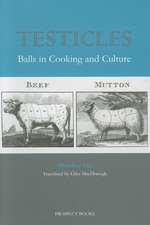Latino Food Culture: Food Cultures in America
Autor Zilkia Janeren Limba Engleză Hardback – 29 mar 2008 – vârsta până la 17 ani
Preț: 226.57 lei
Preț vechi: 391.61 lei
-42% Nou
Puncte Express: 340
Preț estimativ în valută:
43.36€ • 46.36$ • 36.15£
43.36€ • 46.36$ • 36.15£
Carte tipărită la comandă
Livrare economică 18 aprilie-02 mai
Preluare comenzi: 021 569.72.76
Specificații
ISBN-13: 9780313340277
ISBN-10: 0313340277
Pagini: 200
Dimensiuni: 156 x 235 x 21 mm
Greutate: 0.46 kg
Editura: Bloomsbury Publishing
Colecția Greenwood
Seria Food Cultures in America
Locul publicării:New York, United States
ISBN-10: 0313340277
Pagini: 200
Dimensiuni: 156 x 235 x 21 mm
Greutate: 0.46 kg
Editura: Bloomsbury Publishing
Colecția Greenwood
Seria Food Cultures in America
Locul publicării:New York, United States
Notă biografică
Zilkia Janer teaches Latin American and Latino literature and Culture at Hofstra University. She is the author of Puerto Rican Nation-Building Literature: Impossible Romance (2005) and has published a number of articles on Latin American and South Asian culinary cultures.
Cuprins
Series ForewordAcknowledgmentsIntroductionChronology1. Historical Overview2. Major Foods and Ingredients3. Cooking4. Meals5. Eating Out6. Special Occasions7. Diet and HealthGlossaryResource GuideBibliographyIndex
Recenzii
From national holidays and special occassion celebrations to regional recipes which have made it to the U.S., Latino Food Culture is packed with cultural, social and culinary insights and connections and is especially recommended for any college-level library strong in Latin culture and food.
Readers learn in Latin Food Culture that although various Latin American and Latino cuisines have always been a part of the American experience, they are even more so now because of the recent growth of the Latino population. Each volume in this series contains a foreword, an introduction, a chronology, line drawings and photos, recipes, a glossary, a resource guide, a selected bibliography, and an index.
Janer.has produced an excellent introduction to Latino culinary practices. This monograph is one of a five volume series on food cultures in America. The text follows the uniform outline for the other volumes, which includes a timeline of important culinary events, an historic overview, ingredients, meal preparation and other socio/cultural aspects of food. Janer excels at highlighting how Latinos, while not a homogenous group, share a rich and varied culinary tradition. .The book is a great resource for readers interested in Latino cooking and for American born Latino/as wanting to reconnect with their culinary heritage. This is an excellent addition to all media centers, public and academic libraries.
The text is easy to read and very enjoyable in its content; the glossary is extremely helpful for new arrivals to this type of cuisine. The chapter has a bibliography to obtain more information on the subject matter. It is well indexed. The book has appropriate binding, the paper is average; and font size is sufficient. This book should be in all food-oriented libraries. It will be particularly useful for students studying in food culture since the Latino population is growing in this country and consequently will be important in their future.
Readers learn in Latin Food Culture that although various Latin American and Latino cuisines have always been a part of the American experience, they are even more so now because of the recent growth of the Latino population. Each volume in this series contains a foreword, an introduction, a chronology, line drawings and photos, recipes, a glossary, a resource guide, a selected bibliography, and an index.
Janer.has produced an excellent introduction to Latino culinary practices. This monograph is one of a five volume series on food cultures in America. The text follows the uniform outline for the other volumes, which includes a timeline of important culinary events, an historic overview, ingredients, meal preparation and other socio/cultural aspects of food. Janer excels at highlighting how Latinos, while not a homogenous group, share a rich and varied culinary tradition. .The book is a great resource for readers interested in Latino cooking and for American born Latino/as wanting to reconnect with their culinary heritage. This is an excellent addition to all media centers, public and academic libraries.
The text is easy to read and very enjoyable in its content; the glossary is extremely helpful for new arrivals to this type of cuisine. The chapter has a bibliography to obtain more information on the subject matter. It is well indexed. The book has appropriate binding, the paper is average; and font size is sufficient. This book should be in all food-oriented libraries. It will be particularly useful for students studying in food culture since the Latino population is growing in this country and consequently will be important in their future.























